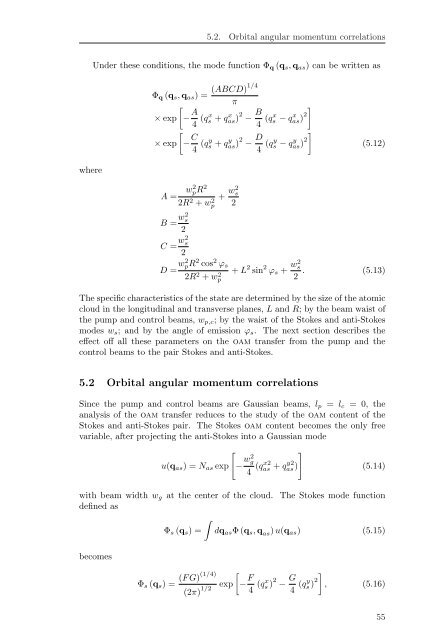Spatial Characterization Of Two-Photon States - GAP-Optique
Spatial Characterization Of Two-Photon States - GAP-Optique
Spatial Characterization Of Two-Photon States - GAP-Optique
Create successful ePaper yourself
Turn your PDF publications into a flip-book with our unique Google optimized e-Paper software.
where<br />
5.2. Orbital angular momentum correlations<br />
Under these conditions, the mode function Φq (qs, qas) can be written as<br />
Φq (qs, qas) = (ABCD)1/4<br />
<br />
π<br />
× exp − A<br />
4 (qx s + q x as) 2 − B<br />
4 (qx s − q x as) 2<br />
<br />
<br />
× exp − C<br />
4 (qy s + q y as) 2 − D<br />
4 (qy s − q y as) 2<br />
<br />
A = w2 pR2 2R2 + w2 +<br />
p<br />
w2 s<br />
2<br />
B = w2 s<br />
2<br />
C = w2 s<br />
2<br />
D = w2 pR 2 cos 2 ϕs<br />
2R 2 + w 2 p<br />
(5.12)<br />
+ L 2 sin 2 ϕs + w2 s<br />
. (5.13)<br />
2<br />
The specific characteristics of the state are determined by the size of the atomic<br />
cloud in the longitudinal and transverse planes, L and R; by the beam waist of<br />
the pump and control beams, wp,c; by the waist of the Stokes and anti-Stokes<br />
modes ws; and by the angle of emission ϕs. The next section describes the<br />
effect off all these parameters on the oam transfer from the pump and the<br />
control beams to the pair Stokes and anti-Stokes.<br />
5.2 Orbital angular momentum correlations<br />
Since the pump and control beams are Gaussian beams, lp = lc = 0, the<br />
analysis of the oam transfer reduces to the study of the oam content of the<br />
Stokes and anti-Stokes pair. The Stokes oam content becomes the only free<br />
variable, after projecting the anti-Stokes into a Gaussian mode<br />
u(qas) = Nas exp<br />
<br />
− w2 g<br />
4 (qx2 as + q y2<br />
as)<br />
<br />
(5.14)<br />
with beam width wg at the center of the cloud. The Stokes mode function<br />
defined as<br />
<br />
Φs (qs) = dqasΦ (qs, qas) u(qas) (5.15)<br />
becomes<br />
<br />
(F G)(1/4)<br />
Φs (qs) = exp −<br />
1/2<br />
(2π) F<br />
4 (qx s ) 2 − G<br />
4 (qy s ) 2<br />
<br />
, (5.16)<br />
55



